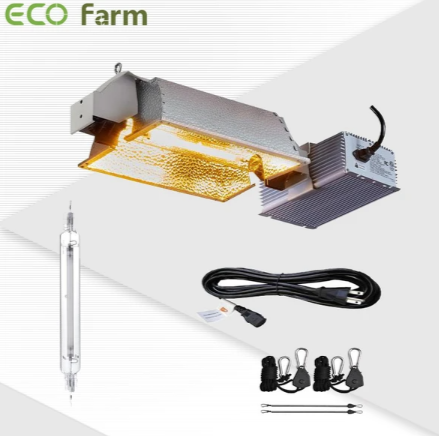Growing cannabis indoors has a lot of advantages. It provides you with total control over your plant’s environment. It’s discreet, and it gives cannabis lovers without outdoor gardens a chance to connect with the amazing plant.
Unfortunately, there’s one seemingly big downside to indoor growing: the cost. That being said, it’s not nearly as much of an issue if you’re aware of, and prepared for, said costs. Read on for an in-depth breakdown of what you’ll have to pay to grow in an indoor tent/room. We’ll also teach you how to keep those costs minimised and get the most for your money.
Why should I use indoor cannabis grow lights?
Indoor cannabis indoor grow lights offer several benefits and cultivators have virtually endless options to choose from, according to Michael Zartarian, an engineer at Zartarian Engineering and the RII Technical Advisory Council. "We are living in the golden age of grow lights. There have never been so many high-quality options available to home and commercial growers," he said.
Some of the reasons he touts indoor grow lights are:
Cost-effectiveness
Efficiency
Productivity
Safety
Standardized technology
Third-party testing and verification
What type of light is best for growing plants indoors?
"Generally, white light with a 'bright white' appearance is used for growing small and vegetative plants indoors," according to Gretchen Schimelpfenig, RII's Technical Director. Specifically, LED grow lights are the recommended type for indoor marijuana cultivators for the reasons listed in the section above. Enhanced organic compound expression is possible with LEDs, meaning growers may see enhanced cannabis properties.
Can any LED light be used as a grow light?
Technically, yes, any LED grow light can be used as a grow light. However, there are some that work better depending on the stage of growth that the cannabis plant has entered. Zartarian noted that any standard 150 watt LED white light bulb could adequately nurture a small cannabis plant in the early stages of life.
As the cannabis plant matures, its need for light will change. "As the plant gets bigger and matures into the flowering stage of its life, it requires much more light over a wider area to grow optimally. This is where high-power, purpose-built grow lights are needed to get the job done properly," explained Zartarian. In terms of what to look for, Schimelpfenig pointed out that growers can “trust third-party certifying organizations to test and validate the claims made by manufacturers.
ECO Farm 1000W Double Ended HPS HID Grow Light

PROS
Simple and powerful
Bulbs guaranteed for 1 year (free replacement)
Supports excellent harvest
CONS
Puts out a lot of heat
May ship rough (covered by warranty)
Things to Consider When Buying HPS Grow Lights
First off, you’ll want to consider whether you have enough ceiling space to handle HPS lights. If you look at any distance-from-foliage chart for HPS grow lights, you’ll see that 1000W bulbs need to be hung at least 24″ from the top of the plant canopy.
If you’ve got the space for growing weed indoors with high pressure sodium lights, here are a few more things to consider:
Coverage Area
Like all types of grow light bulbs, HPSs come in a range of sizes and wattages. The size and wattage value you choose determines the light’s coverage area (and the hanging distance from the plant canopy).
The higher the wattage, the greater the coverage area and the more distance required from bulb to canopy. The most common wattages for HPS lights are 150, 250, 400, 600, and 1000. A 150W bulb can handle a 1.5’x1.5’ space while 1000W can handle 6’x6’.
Single or Double-Ended
Single-ended HPS bulbs look like a traditional incandescent lightbulb that is screwed in on just one side. Double-ended bulbs look more like fluorescents since they screw into the system on both sides. So which one is better, single or double-ended?
Double-ended 1000W HPS grow lights are pricier, but they also come with a lot of advantages. Both the pros and weed-growing hobbyists are using double-ended HPS systems for maximum yields and more even distribution of light.
But if you’re a beginner, it’s completely understandable to start with a more basic (not to mention more affordable) single-ended HPS.
Air-Cooled Design
So you already know that one of the drawbacks to using HID grow lights is the high heat output, but there’s a solution: the air-cooled design. Air-cooled lights work to eliminate excess heat from the garden. Here’s how…
The heat from the bulb is contained within a chamber (there’s a sheet of glass keeping the heat from escaping over the plant canopy). There’s a venting hole in the light’s hood for ducting (usually 4 or 6”), allowing you to pump the heat from the light chamber out of the grow room.
If you’ve got the money to spend, we recommend buying an air-cooled HPS. But since this is more advanced technology, low-scale ACMPR growers with strict budgets often think of other ways to cool down the room or tent.
Read our article on renewing your ACMPR license here.
Cost & Warranty
Cost is an obvious buying factor, but the good news is that the average price of HPS grow lights is less than LEDs. Just try to avoid anything that’s suspiciously cheap – it’s probably cheap for a reason.
Final thoughts
Indoor grow lights are known for facilitating large yields of high-quality cannabis and can help you take your harvest to the next level.